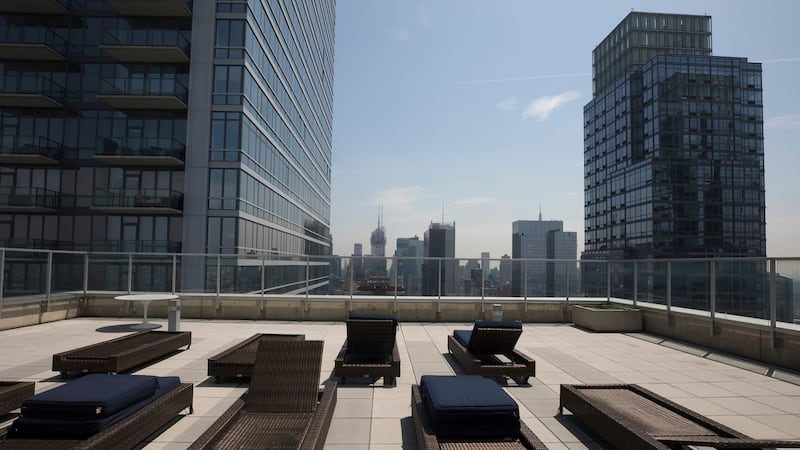In the 1920s, when "Gilded Age" plutocrats reigned in Manhattan, an heiress agreed to an unheard-of deal. She traded her Fifth Avenue mansion for an apartment atop a new building. But she had her demands. A private entrance with its own driveway. And a private elevator. She got them, along with a 54-room apartment, including a dining room that could seat 125 and a cold storage room for her furs and flowers.
An architectural historian described it as “the largest and very possibly the most luxurious apartment ever created anywhere”.
So was born a Manhattan penthouse. Now, in another time of extreme wealth in New York, super-luxury buildings are rising higher than ever, with prices to match.
With such an abundance of opulence how do you attract buyers? Promise a trip to space. Yes, two seats on a future space flight.
But there is more. The apartment in question comes with a house in the Hamptons for one summer; three cars (two Rolls-Royces and a Lamborghini); a yacht with docking fees for five years; season tickets to Nets home games; dinner once a week at the two-Michelin-star restaurant Daniel; a private chef for a year; a butler; and a $2 million construction allowance for renovations.
It also comes with a stratospheric asking price: $85 million, or about 92 times the average price of a home in New York City, according to Census Bureau data.
It went on the market a year ago, and hasn’t sold yet. Still, even in a city of extremes, it was only the third most expensive apartment when the real estate website Curbed listed the 25 priciest homes for sale in New York a couple of months ago. “The uppermost echelon of real estate in the city is still, well, ridiculous,” Curbed declared, noting that “the lower end of the list” was around $45 million.
The prices reflect the luxuriation of Manhattan as money continues to pour into ultra-expensive apartments, and developers build for the richest of the rich.
The tsunami of capital is shifting the landscape. The research firm CoStar Group estimated that 80 per cent of the apartments under construction in Manhattan were in luxury-level buildings. City-wide, the figure is 74 per cent.
Jonathan Miller of appraisal firm Miller Samuel said he defined the top 10 per cent of the market, everything above $5.8 million, as luxury – a term he said had become the most overused word in real estate.
Trophy market
Apartments above about $20 million represent “the top 1 per cent or less” of the total market. “You could call it the trophy market. It’s a very rarefied market segment.”
And it has the optics. It is what “people outside of Manhattan look at Manhattan through”, Miller said. “They assume that that’s the market in general.” Yet roughly half of the apartments sold in Manhattan go for less than $1 million – “not to be cavalier about a million dollars”.
Still, an address in the highest of high-end buildings in New York has become a coveted prize for many of the wealthiest buyers.
“You’re seeing the results of the incredible growth of inequality between the rich, the super-rich and the absolutely ridiculously, obscenely rich,” said Philip Kasinitz, a professor of sociology at the City University of New York’s Graduate Center. “The distance between just being pretty wealthy and having this kind of money has hugely increased.”
In the original “Gilded Age” (1870s to 1900) New York pushed out horizontally, reaching toward what became the suburbs. But it also pushed up, for work.
“New York began to pile office floor upon office floor to create the splintered skyline that heralded the profile of the 20th century American city,” wrote architectural historian James O’Gorman.
In the new “Gilded Age” the city has pushed up for living space, with ever-taller buildings – and eye-popping prices – led by a $238 million condominium on Billionaires’ Row, as the area south of Central Park and bracketed by supertall buildings has come to be known.

This latest apartment has beaten the previous high price in New York City, a duplex a couple of blocks away that sold for nearly $100.5 million in 2015, reportedly to Michael Dell, the computer entrepreneur.
“What luxury means has changed,” Miller said. “In the 1950s you had midrise buildings that were called ‘luxury’ because they had an elevator and a doorman. You’d see signs: ‘Air conditioning, doorman and elevators – luxury building.’ Now you’re on the 96th floor, and you have a pool and a slew of amenities in the building.”
And bigger homes. In Manhattan one in five new condos has at least three bedrooms, up from one in 20 in the 1990s, Miller said.
Extras
The size of the $238 million apartment is 24,000sq ft, which works out at $9,917 a square foot. The $85 million apartment with the extras, marketed by Daniel Neiditch, a broker who is also the president of the condominium association in the building, covers 15,000sq feet, a relative bargain by comparison at $5,667 a square foot if it sells for $85 million.
The building is on West 42nd Street, between 11th and 12th avenues – once more Skid Row than Billionaires’ Row. Last year city law enforcement agents conducted a raid on the building over illegal rentals arranged on Airbnb. Neiditch said that at least half the violations had been dismissed, and added that there had been no violations since the raid.
Neiditch said that 20 years ago “this was a terrible place to be”. The building took the place of a stable for police horses. A gas station was next door, and a parking lot was across the street. Tall new buildings have long since replaced both.
Neiditch’s building offers the kinds of amenities that have become standard – and expected – in many new buildings: a private movie theatre, a state-of-the-art gym and a well-equipped playroom. But his inducements are flashier than at other condominiums, where incentives sometimes include paying buyers’ property taxes or common charges for a year or two.

Neiditch said he was selling not just an apartment but an immersive experience, even if many luxury apartments are pieds-a-terre that go empty while their owners are gallivanting where the ultra-wealthy gallivant. For someone who has not lived in New York, he said, the incentives would “give them the basis of a New Yorker’s lifestyle”.
“Dinner at Daniel’s gives them a place they can go,” he said. “Courtside seats to the Nets gives them sports. They’ll have cars. They’ll be able to go out to the Hamptons without having to look for a place.” Or cope with the headache that is the Long Island Expressway. “A sail out to the Hamptons could be fun,” he said, “or take the boat and go down to the Caribbean.”
Neiditch said there had been discussions with one would-be buyer, but the deal breaker was the elevator. The would-be buyer insisted on a private one.
Arched window
So did heiress Marjorie Merriweather Post, who swapped her mansion for the 54-room apartment in the 1920s. “Part of her deal when she said ‘I’ll sell you my mansion’ was that they would build a triplex for her at the top, with a huge, arched window,” said architectural historian Andrew Dolkart.
As Robert AM Stern, writing with Gregory Gilmartin and Thomas Mellins, explained in the book New York 1930, she was “unwilling to mix with the building’s hoi polloi who occupied the lower floors”. They came and went through the Fifth Avenue entrance. She had her own entrance around the corner on East 92nd Street “from which a private elevator whisked her and her guests to a grand foyer”.
Neiditch’s building has its limitations. It has only four elevators, and Neiditch said making one of them private was a demand he could not meet. He would not identify the prospective buyer who wanted the elevator, but said the person “did not wish to be seen by anyone else”. He said he offered a private entrance through the building’s garage, but the person would still have had to take the elevator.
“They wanted a private elevator for their use at all times even though the person probably wouldn’t be here 300 days out of the year. It was just something they were stuck on.”
As for the space flight, a departure date has yet to be set. Neiditch would not discuss details of the arrangements. “But you’ll have two seats on that, which is just a cool perk to have.”
– New York Times









